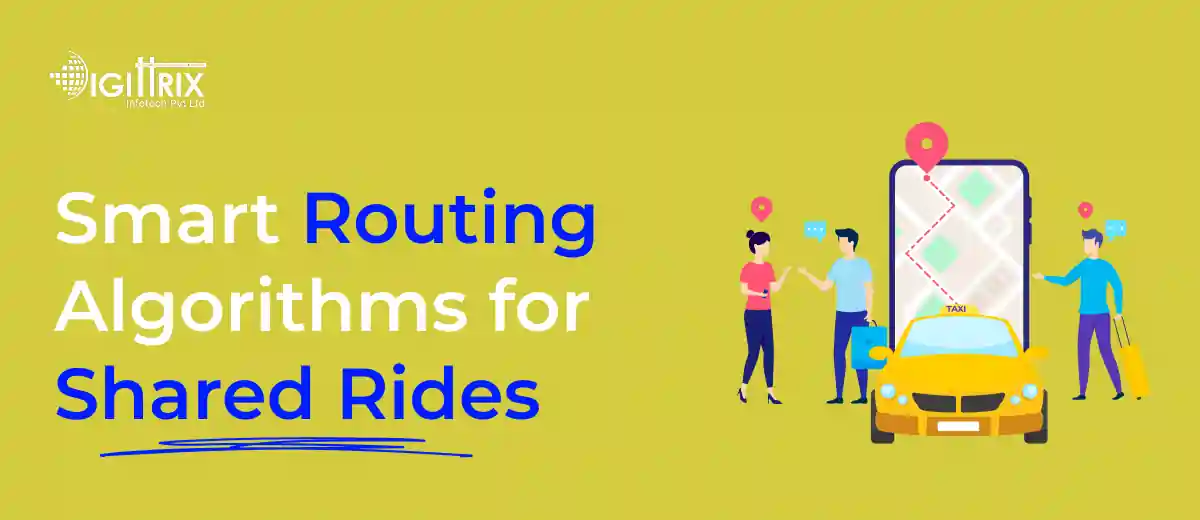Smart routing algorithms for shared rides optimize routes, match passengers efficiently, reduce costs, and enhance travel times through advanced data-driven planning in ridesharing platforms.
Highlights
With Over 14 years of Experience in the IT Field, Helping Companies Optimise there Products for more Conversions

Shared rides have become a vital part of modern transport. People opt for them to save money, ease traffic congestion, and help the environment by reducing fuel use. Behind the smooth operation of these services is a complex system called smart routing algorithms. These algorithms determine how passengers are grouped, the route to follow, and how to manage time effectively.
With the growth of Ridesharing app development, technology companies have been seeking better ways to make shared rides quicker and more affordable. By employing advanced route optimisation techniques, ridesharing platforms can link multiple passengers with similar travel routes without causing major delays for anyone.
Explore ride-sharing in 2025: Learn about the top alternatives and must-have features for choosing or building the best ride-sharing platform.
A routing algorithm is a process that determines the optimal path between two or more locations. For shared rides, the “best path” is not simply about the shortest distance—it involves balancing time, passenger satisfaction, and operating costs.
In on-demand ridesharing app systems, smart routing algorithms operate in real-time. They consider factors like:
These algorithms continuously update as conditions change, enabling efficient planning during the trip itself.
Shared ride services differ from traditional taxi services because multiple passengers can share the same vehicle. This makes the routing process more complex. Without smart routing, passengers could encounter unnecessary detours, long wait times, or higher costs.
For example, if three passengers book rides in different parts of the city, the system must decide:
The success of carpooling app development largely depends on how effectively the routing algorithm manages these tasks. If it fails to plan efficiently, passengers might find the trip inconvenient, leading to negative experiences.
At its core, smart routing blends various mathematical and data-driven methods. Here’s a step-by-step overview of how it functions within a ridesharing setting.
When a passenger requests a ride through a ridesharing platform, the system logs their pickup and drop-off locations along with the preferred time. The same applies to all other passengers requesting rides at that time.
The algorithm compares ride requests to check if they overlap in route and time. This matching process is vital for the best ridesharing apps, as it impacts both efficiency and customer satisfaction.
Once passengers are matched with a driver, the routing system determines the sequence of pickups and drop-offs. It also considers current road conditions, traffic congestion, and potential delays.
Traffic conditions can change rapidly. Smart routing systems continuously get live traffic updates and modify the route when needed.
Different algorithms can be used depending on the ridesharing platform’s needs. Some common types include:
This is one of the most common algorithms for finding the shortest path between two points. While effective for simple routes, it requires modifications for shared ride scenarios involving multiple stops.
This offers a quicker alternative to Dijkstra’s algorithm by using heuristics (educated guesses) to find paths faster. It is commonly employed in ridesharing app development companies.
These algorithms imitate natural selection to evaluate various routing options and select the best one. They are beneficial when the system must manage many passengers and multiple routes simultaneously.
This approach divides the routing problem into smaller parts, solves each part, and then merges the solutions. It performs well for fixed routes but can be adapted for real-time ride planning.
Even with advanced technology, implementing smart routing systems presents several challenges.
To make routing more efficient in shared ride systems, certain features need to be included in the software.
Using smart routing systems provides various advantages for passengers, drivers, and service providers.
Let’s look at an example scenario:
The smart routing system analyzes:
Businesses that specialise in transportation technology often include smart routing in their ridesharing app development projects. The process generally involves:
While traditional algorithms form the foundation of routing systems, AI and machine learning are now assisting in making them more intelligent. Machine learning models can:
As city populations expand, the demand for improved shared ride services will keep rising. Smart routing is likely to develop in these ways:
Planning to build a bike taxi app? Learn how to pitch your ride-sharing app startup to investors.
Smart routing algorithms are the backbone of shared ride efficiency. They integrate traffic data, passenger requests, and advanced route planning techniques to deliver cost-effective and time-efficient journeys. Although challenges like unpredictable traffic and passenger preferences persist, ongoing advancements in algorithm design and data processing are making shared rides more viable for daily travel.
Companies developing on-demand ridesharing apps or investing in carpooling app development understand that routing efficiency directly impacts customer satisfaction and business success. As cities expand and transportation needs evolve, these algorithms will become even more crucial in shaping how we get from one place to another.
By merging technological advances with real-world requirements, the future of smart routing in shared rides appears promising for both service providers and passengers.
In today’s connected world, effective shared transport depends on smart route planning. Clever routing algorithms are crucial for successful ride-sharing services, helping drivers pick up and drop off multiple passengers while lowering travel time and costs. A well-crafted system not only improves passenger convenience but also increases operational efficiency for providers.
At Digittrix, we excel in ridesharing app development with advanced smart routing technology. Our solutions, whether ready-made for a quick market launch or fully customised for particular business needs, use real-time data to plan optimal routes, match riders efficiently, and adapt trips as conditions evolve.
If you want to launch a high-performing on-demand ridesharing or carpooling app project that features intelligent route optimisation, our experienced team is ready to assist. Contact us today at +91 8727000867 or email digittrix@gmail.com to discuss your project.
Let’s build a feature-rich ridesharing platform powered by intelligent routing algorithms that gives your business an edge in the competitive mobility market.

Do you need help in Mobile App development?




Join over 1500+ businesses we've already helped!
Beauty App Development: Tips to Grow Your Business Through an App & Cost in India (2026)
A smart routing algorithm is a system that finds the most efficient route for multiple passengers in a shared ride, taking into account time, cost, and traffic.
They assist in cutting travel time, conserving fuel, and enhancing the passenger experience by optimizing routes and grouping riders effectively.
Ridesharing apps utilize these algorithms to match passengers, determine pickup and drop-off orders, and modify routes in real time depending on traffic conditions.
Yes. By pooling multiple passengers into fewer vehicles and choosing shorter routes, smart routing cuts fuel consumption and decreases carbon emissions.
Common technologies include GPS, live traffic data integration, artificial intelligence, and machine learning for predictive route adjustments.

©2026Digittrix Infotech Private Limited , All rights reserved.